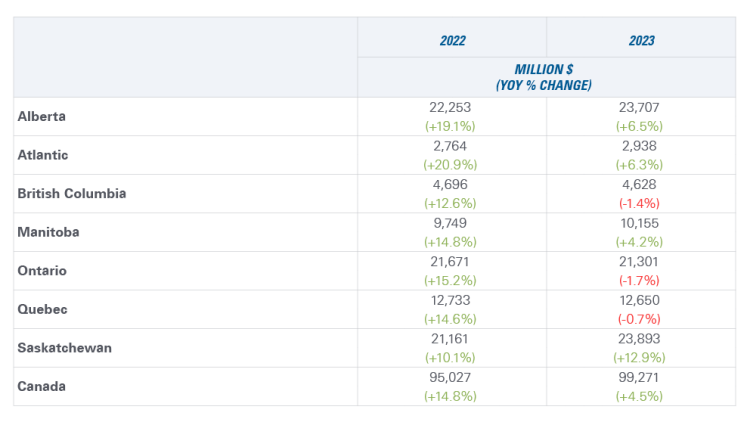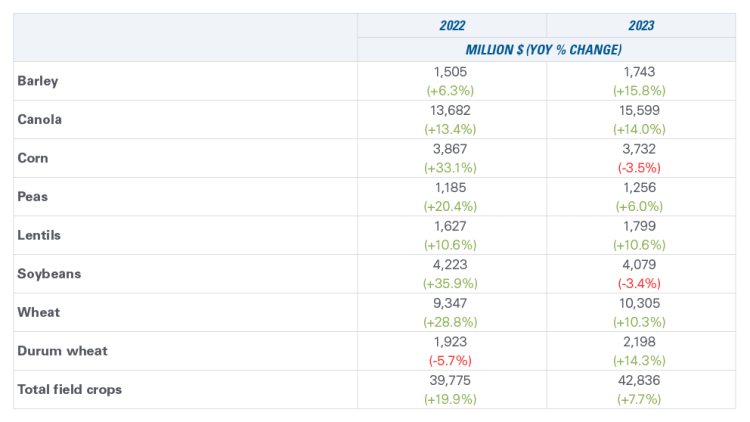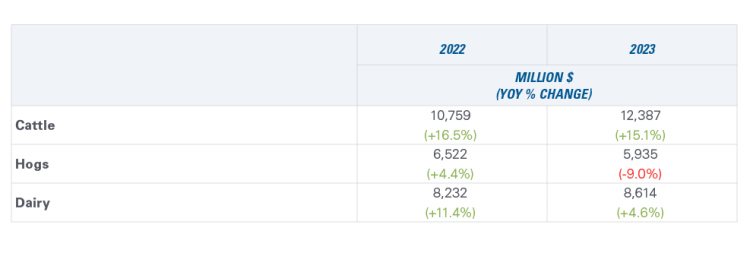2023 farm cash receipts update: Hog sector struggles amid ag industry growth

In our January forecasts, we expected farm cash receipts (FCR) to continue growing in 2023, although at a more moderate pace than in 2022. While specific sectors’ FCR have varied since January, our June projections for total Canadian FCR are unchanged. We forecast the 2023 FCR to grow by 4.5%, helping offset some high input costs.
This analysis only looks at the revenue side of the ledger, and higher FCR does not necessarily mean that farm profits are increasing.
Prairies showing growth while hogs limit Quebec and Ontario receipt growth
Statistics Canada released the 2022 FCR in May, along with revisions for previous years. The revisions were large enough to change the direction of several 2023 forecasts. Corn, for example, is now forecast to be down year-over-year (YoY) because they revised 2022 upwards so significantly, while our initial 2023 forecast has only increased slightly.
Our 2023 projections of YoY changes in FCR (Table 1) incorporate StatCan FCR estimates for the first quarter and data from other sources. The largest projected increases in 2023 FCR are in the Prairie provinces and Atlantic Canada. Ontario and Quebec are projected to decline in 2023 primarily due to weaker hogs and crop receipts. British Columbia’s decline is due to total crop receipts declining.
Table 1: Actual and projected FCR by province/region

Sources: FCC forecasts use Statistics Canada table 32-10-0077 for prices, table 32-10-0046 for FCR and table 32-10-0351 for deliveries; futures data from CME.
Grains, oilseeds and pulses receipts continue to grow in 2023 after a strong 2022
FCR for grains, oilseeds and pulses are projected to grow 7.7% in 2023 (Table 2) and follow strong growth of 19.9% in 2022. Our projected growth in 2023 has declined slightly from January’s forecast due to 2022 actual data being revised higher.
Corn and soybean receipts are forecast to be lower in 2023. While 2022 saw historically high crop prices, some regression can be expected in 2023. In the Prairies, strong growth is still expected for crops like canola, wheat, peas, and lentils as the remainder of the 2022 crop is marketed, and current expectations are for average yields in 2023. Crop prices remain above their 5-year average due to tight global stocks-to-use ratios. Of course, developing dry conditions in the U.S. and Russia threatening not to extend the Black Sea agreement could lift prices in the second half of 2023 and lead to higher realized receipts than our current forecasts.
Table 2: Actual and forecasted FCR for selected crops

Sources: FCC forecasts use Statistics Canada table 32-10-0077 for prices, table 32-10-0046 for FCR and table 32-10-0351 for deliveries; futures data from CME.
Livestock receipts heading in different directions
What a difference six months have made for cattle and hog markets. Cattle prices have continued to increase since January, outweighing lower marketed volumes and pushing forecasted FCR up 15.1% for 2023 (Table 3). This is on the back of 16.5% growth in 2022 when strong consumer demand outpaced the available supply of a declining North American cattle herd. Continued strong cattle pricing has increased our 2023 FCR projections since January.
In sharp contrast, the outlook for hogs is challenging. U.S. hog futures prices have weakened due to lower export demands as Chinese pork production rebounded from recent lows. In addition, Canadian prices have been further impacted by slaughter capacity constraints in eastern Canada. These unexpected market factors have brought turmoil to the hog industry and changed our 2023 hogs FCR forecast from being initially positive in January to a 9.0% decline in FCR.
Table 3: FCR actual and forecasts for selected livestock sectors

Sources: FCC forecasts use Statistics Canada table 32-10-0077 for prices, table 32-10-0046 for FCR and futures data from CME.
In response to increasing costs for feed and energy, the Canadian Dairy Commission increased the support price for butter on February 1st, 2023, estimating it will result in a 2.2% increase in the milk price. Marketed milk is forecast to grow slightly as well, and, as a result, dairy FCR are projected to grow by 4.6% in 2023. This growth is slightly lower than the January forecast.
Bottom Line
We expect FCR growth for most agricultural sectors in 2023. The projected small declines in corn and soybeans are due to 2022’s excellent and better-than-anticipated prices and yields. Hog FCR projections have flipped from positive to negative in the year’s first six months, showing how quickly the ag economy can change. The big turn in fortunes further illustrates the need for effective risk management strategies. Heading into summer, crop yields and prices will depend on good weather to bring a strong conclusion to 2023.

Justin Shepherd
Senior Economist
Justin Shepherd is a Senior Economist at FCC. He joined the team in 2021, specializing in monitoring agricultural production and analyzing global supply and demand trends. In addition to his speaking engagements on agriculture and economics, Justin is a regular contributor to the FCC Economics blog.
He grew up on a mixed farm in Saskatchewan and remains active in the family operation. Justin holds a master of applied economics and management from Cornell University and a bachelor of agribusiness from the University of Saskatchewan.
